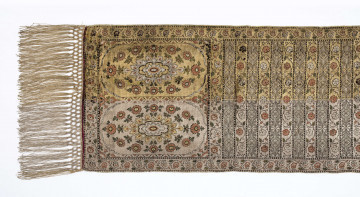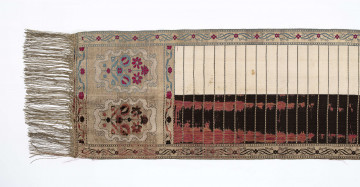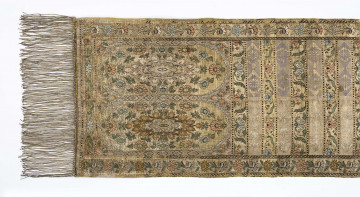
Kontusz belt
1789 — 1793
National Museum in Lublin
Part of the collection: Textiles, embroideries, clothing and costume accessories
Made of silk, stitched with silver thread, the one-sided, half-lined kontusz belt, dating from the second half of the 18th century, was an indispensable element of the national costume of the Polish nobleman. Although the kontusz belt originated in distant Persia, from where it was probably initially imported, it was in Poland that it gained immense popularity. Some of them were so delicate and thin that, according to legend, they could be threaded through the rim of a ring.
At one time, the popularity of kontusz belts in Sarmatian Poland was so enormous that importing them from the Middle East not only doubled the cost of transport, but also significantly increased the waiting time for ordered goods. It was for this reason, among others, that local manufactories started to emerge, such as the Grodno manufactories, from which the belt in the Lublin Museum's collection probably originates. The manufactories employed many draughtsmen and designers, as the ever-growing interest in luxury goods required manufacturers of precious belts to constantly create new designs. Jan Ludwik Inard, in charge of one such factory, paid great attention to all novelties, both in art and fashion. Thus, in one of his supplications addressed to the King, he wrote that he dreamt of having fresh samples of new fabrics every three months, "so that he could conduct the factory according to fashion and taste".
At the royal manufactory in Grodno, fabric designs were devised by pattern makers, then sent to draftsmen, who translated the design to scale into so-called grids, so that the drawing would be legible to the weaver. The royal silk factory, which was established on a grand scale with money from the king's table goods, employed too many people. Artists, designers, draftsmen, weavers and technical assistants working in the manufactory, even though they created new and original patterns, and thus produced unique kontusz belts, were not able to bring the factory descent income, which led to the collapse and closure of the royal manufactory.
Author / creator
Dimensions
cały obiekt: height: 320 cm, width: 28 cm
Object type
a contoured belt
Technique
weaving
Material
silk (natural fabric), silver metal thread
Creation time / dating
Creation / finding place
Owner
The National Museum in Lublin
Identification number
Location / status

1789 — 1793
National Museum in Lublin

1767 — 1780
National Museum in Lublin

1781 — 1806
National Museum in Lublin
DISCOVER this TOPIC
National Museum in Lublin
DISCOVER this PATH
Educational path